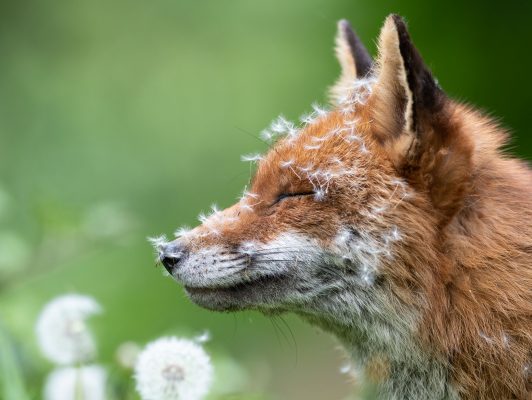[ad_1]
Nature’s fierce beauty emerges forcefully from the 2023 British Wildlife Photography Awards. Our Picture Editor Lucy Ford has the pick of the best shots, from a somnolent fox to a hungry buzzard, with words by Carla Passino.
Mid- air in a leaden Gloucestershire sky, a buzzard ambushes a barn owl, one talon viciously grabbing the smaller bird, the other making for its prey, a tiny vole.
In an urban wildflower patch, a vixen wakes up from her slumber covered in a fuzz of dandelion seed-heads.
In the Shetlands, a skua — wings spread, beak wide open — looks every inch the pirate on its cliff.
And in a London park, three ducklings snooze peacefully as the metropolis whirls busily around them.
British Nature, in all its charming, red-toothed glory, bursts from the pages of the British Wildlife Photography Awards 11, a book collating the best entries to the 2023 British Wildlife Photography Awards competition.

The biter bit: a horsefly ensnared by a sundew in A Poet’s Lunch, taken by Matt Doogue © Matt Doogue / British Wildlife Photography Awards
It is the first time the contest has taken place since covid and the judges had a hard time choosing the winners from more than 13,000 images, which they evaluated not only for skill, creativity and craft, but also, as director Will Nicholls explains, for upholding ‘strict values when it comes to the wellbeing of the subjects’.

An affinity between a meticulous nesting jackdaw and a photographer with an eye for detail is clear in Samuel Stone’s Rocks. © Samual Stone / British Wildlife Photography Awards
The shots are a triumph of wide-eyed sharks, leaping bunnies, fuzzy owlets and seahorses so stern they’d put a headmistress to shame.

A vole is the centre of The Ambush, a buzzard attacking a barn owl trying to feed its chicks in a battle captured by Frank Thompson. © Frank Thompson / British Wildlife Photography Awards
They run the gamut from the majestic — a lone stag silhouetted against snow-capped Highlands, a red kite, flying fierce and undeterred in heavy snow flurry — to the wondrous (an underwater picture of plankton reminiscent of the night sky) and the curious, such as an amphibian threesome in which two male toads try to hitch a lift on the same female or the great bustard that wanders, much like a bewitched tourist, around Stonehenge.
Some photographs issue a stark warning about the fragility of our habitats.

Warmth, light and cars to deter predators: an ideal spot in Amber Nesting by Daniel Trim. © Daniel Trim / British Wildlife Photography Awards
In a shot of great crested grebes courting, the first bird brings a present of pondweed, but the second proffers a piece of plastic, highlighting, as judge David Plummer puts it, ‘our own species’ flagrant disregard for the environment’.

Ooh, you look yummy! An eager mallard duckling tries to catch a mosquito in Dinner on the Lake of Plenty by Victor Soares. © Victor Soares / British Wildlife Photography Awards
Other pictures show wildlife reconquering urban areas — not least the overall winner, a portrait, by Charlie Page, of a proud fox that saunters with more than a soupçon of arrogance past the pylons of London’s Lee Valley Park.
The images capture moments of intimate beauty, too, sometimes tinged by comic relief: Otterly Relaxed, a dog otter relaxing on shore, hind feet up, nose in the air, is a reminder that Nature brings solace to us all.

The Plastic Gift. © Roberto Melotti / British Wildlife Photography Awards
‘British Wildlife Photography Awards 11’ is published by Graffeg (www.graffeg.com) at £30. See more about the awards at www.bwpawards.org

Don’t Drop It! © Sue Morris / British Wildlife Photography Awards

Honey Bee Flight Trails by John Waters. Honey bees (Apis mellifera) leaving ‘light trails’ as they approach their hive entrance (just out of shot in lower right of frame). ‘The shot was taken during lockdown in a small wildlife-friendly garden in Bristol where my partner keeps bees,’ says John. ‘I spent a lot of time watching the bees, trying to work out how I could show their comings and goings at the hive in a way that would convey a sense of movement … their ‘busyness’. I used a slow shutter speed (0.3 secs) and a 2nd curtain flash to ‘freeze’ the bees after they had made their light trails. I placed a makeshift bamboo frame draped with black cloth to create a dark background, and also placed a mirror on a stand to reflect sunlight and direct strong backlighting onto the bees against the dark background.’ © John Waters / British Wildlife Photography Awards

Metallic Jumping Spider in Moss. © Will Atkins / British Wildlife Photography Awards

Patience was required to catch Willughby’s Leafcutter Bee in Ed Phillips’s garden. © Ed Phillips / British Wildlife Photography Awards

Wolffish Romance. © Kirsty Andrews / British Wildlife Photography Awards
[ad_2]
